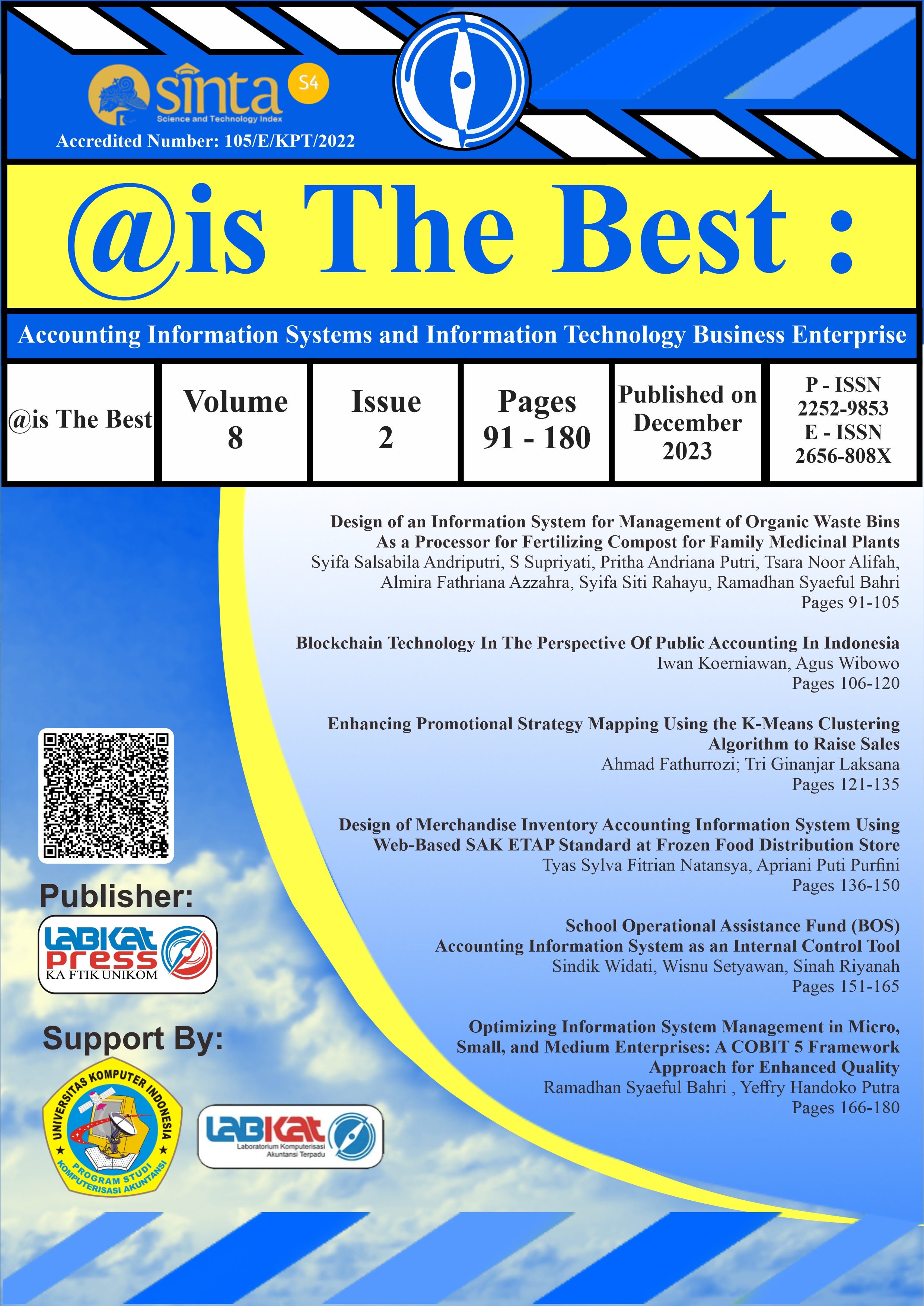Enhancing Promotional Strategy Mapping Using the K-Means Clustering Algorithm to Raise Sales
Main Article Content
Abstract
To enhance sales, organizations must improve the alignment of their promotional tactics. Enterprises have the ability to promote their goods in locations where there is demand for them. Facilitating the delivery of the goods would enhance the ease with which clients can carry out their purchases and sales transactions. A corporation's ability to strategically allocate its goods enables it to expand its operations. Prospective clients have a greater array of choices at their disposal than the total number of enterprises operating within the same sector. This is accomplished by using a diverse range of promotional media to enhance the sales of products and services. Optimizing promotional strategies is the first and critical stage in presenting items to clients, as it directly impacts the benefits that the firm will get. So far, the sales process has not been affected by the promotional method. The objective of this research was to use the K-Means Clustering algorithm in a data mining procedure to optimize the categorization of customer data, CRISP-DM is used for the purpose of comprehending and preparing data, constructing models, evaluating them, and deploying them. The CRISP-DM method is employed specifically for the construction of clusters. A non-hierarchical clustering technique called K-Means divides data into many groups according on how similar they are. The program facilitates the determination of appropriate location mapping for promotional purposes. The study results may serve as a foundation for decision-making in order to maximize promotional techniques, using the generated clusters.
Article Details
Section

This Journal is licensed under a Creative Commons Attribution-ShareAlike 4.0 International License
How to Cite
References
M. C. Thrun, “Swarm intelligence for self-organized clustering,” Artificial Intelligence, vol. 290, 2021, doi: 10.1016/j.artint.2020.103237.
J. Zhang, “Customizing the promotion strategies of integrated air-bus service based on passenger satisfaction,” Transportation Research Part D: Transport and Environment, vol. 109, 2022, doi: 10.1016/j.trd.2022.103385.
L. Zhang, “The promotion of the concept of sustainable development to the reform of enterprise human resource management,” International Journal of Knowledge-Based Development, vol. 13, no. 2, pp. 344–362, 2023, doi: 10.1504/IJKBD.2023.133334.
O. Valentim, “The relation between lifestyles and positive mental health in Portuguese higher education students,” Global Health Promotion, vol. 30, no. 1, pp. 23–32, 2023, doi: 10.1177/17579759221112552.
G. H. Krause, “Computational thinking in a bilingual kindergarten classroom: Emergent ideas for teaching across content areas,” Education and Information Technologies, vol. 28, no. 8, pp. 9767–9782, 2023, doi: 10.1007/s10639-022-11454-1.
G. R. Gagan, “Business Promotion through Instagram using Semi-Supervised Topic Modelling,” 2023 IEEE 8th International Conference for Convergence in Technology, I2CT 2023. 2023. doi: 10.1109/I2CT57861.2023.10126267.
C. S. Reddy, “A Comparative Survey on K-Means and Hierarchical Clustering in E-Commerce Systems,” IDCIoT 2023 - International Conference on Intelligent Data Communication Technologies and Internet of Things, Proceedings. pp. 805–811, 2023. doi: 10.1109/IDCIoT56793.2023.10053472.
Y. Zhang, “Spatial relationships between ecosystem services and socioecological drivers across a large-scale region: A case study in the Yellow River Basin,” Science of the Total Environment, vol. 766, 2021, doi: 10.1016/j.scitotenv.2020.142480.
S. Dong, “Network Abnormal Traffic Detection Model Based on Semi-Supervised Deep Reinforcement Learning,” IEEE Transactions on Network and Service Management, vol. 18, no. 4, pp. 4197–4212, 2021, doi: 10.1109/TNSM.2021.3120804.
R. D. Firdaus, T. G. Laksana, and R. D. Ramadani, “Applying the K-Means method and Hierarchical Clustering Single Linkage to categorise medicine inventory data,” Inista, vol. 8106, pp. 33–48, 2019.
X. Ran, “A novel K-means clustering algorithm with a noise algorithm for capturing urban hotspots,” Applied Sciences (Switzerland), vol. 11, no. 23, 2021, doi: 10.3390/app112311202.
H. Yu, “A three-way density peak clustering method based on evidence theory,” Knowledge-Based Systems, vol. 211, 2021, doi: 10.1016/j.knosys.2020.106532.
M. Ghobaei-Arani, “A workload clustering based resource provisioning mechanism using Biogeography based optimization technique in the cloud based systems,” Soft Computing, vol. 25, no. 5, pp. 3813–3830, 2021, doi: 10.1007/s00500-020-05409-2.
M. Jabi, “Deep Clustering: On the Link between Discriminative Models and K-Means,” IEEE Transactions on Pattern Analysis and Machine Intelligence, vol. 43, no. 6, pp. 1887–1896, 2021, doi: 10.1109/TPAMI.2019.2962683.
T. M. Ghazal, “Performances of k-means clustering algorithm with different distance metrics,” Intelligent Automation and Soft Computing, vol. 30, no. 2, pp. 735–742, 2021, doi: 10.32604/iasc.2021.019067.
S. Yang, “Sports Health Analysis and Promotion Countermeasures of Weak Constitution College Students based on K-Means Clustering: Take a University in Beijing as an Example,” ACM International Conference Proceeding Series. pp. 138–143, 2022. doi: 10.1145/3568364.3568385.
T. Mohith, “A Unified Analysis of Bank Customer Using Machine Learning,” Lecture Notes in Electrical Engineering, vol. 690. pp. 457–463, 2021. doi: 10.1007/978-981-15-7504-4_44.
S. E. A. BUANANTA, “Bi dashboard to support decision making on product promotion for payment/purchase transactions on e-banking,” Journal of Theoretical and Applied Information Technology, vol. 99, no. 15, pp. 3713–3724, 2021, [Online]. Available: https://api.elsevier.com/content/abstract/scopus_id/85112557641
F. Liu, “Determine the Number of Unknown Targets in Open World Based on Elbow Method,” IEEE Transactions on Fuzzy Systems, vol. 29, no. 5, pp. 986–995, 2021, doi: 10.1109/TFUZZ.2020.2966182.
S. Mishra, “A Decisive Metaheuristic Attribute Selector Enabled Combined Unsupervised-Supervised Model for Chronic Disease Risk Assessment,” Computational Intelligence and Neuroscience, vol. 2022, 2022, doi: 10.1155/2022/8749353.
R. Qaddoura, “A multi-stage classification approach for iot intrusion detection based on clustering with oversampling,” Applied Sciences (Switzerland), vol. 11, no. 7, 2021, doi: 10.3390/app11073022.
W. Van Gansbeke, “Unsupervised Semantic Segmentation by Contrasting Object Mask Proposals,” Proceedings of the IEEE International Conference on Computer Vision. pp. 10032–10042, 2021. doi: 10.1109/ICCV48922.2021.00990.
M. Tomasso, “Cluster boosting and data discovery in social networks,” Proceedings of the ACM Symposium on Applied Computing. pp. 1801–1803, 2022. doi: 10.1145/3477314.3507243.

